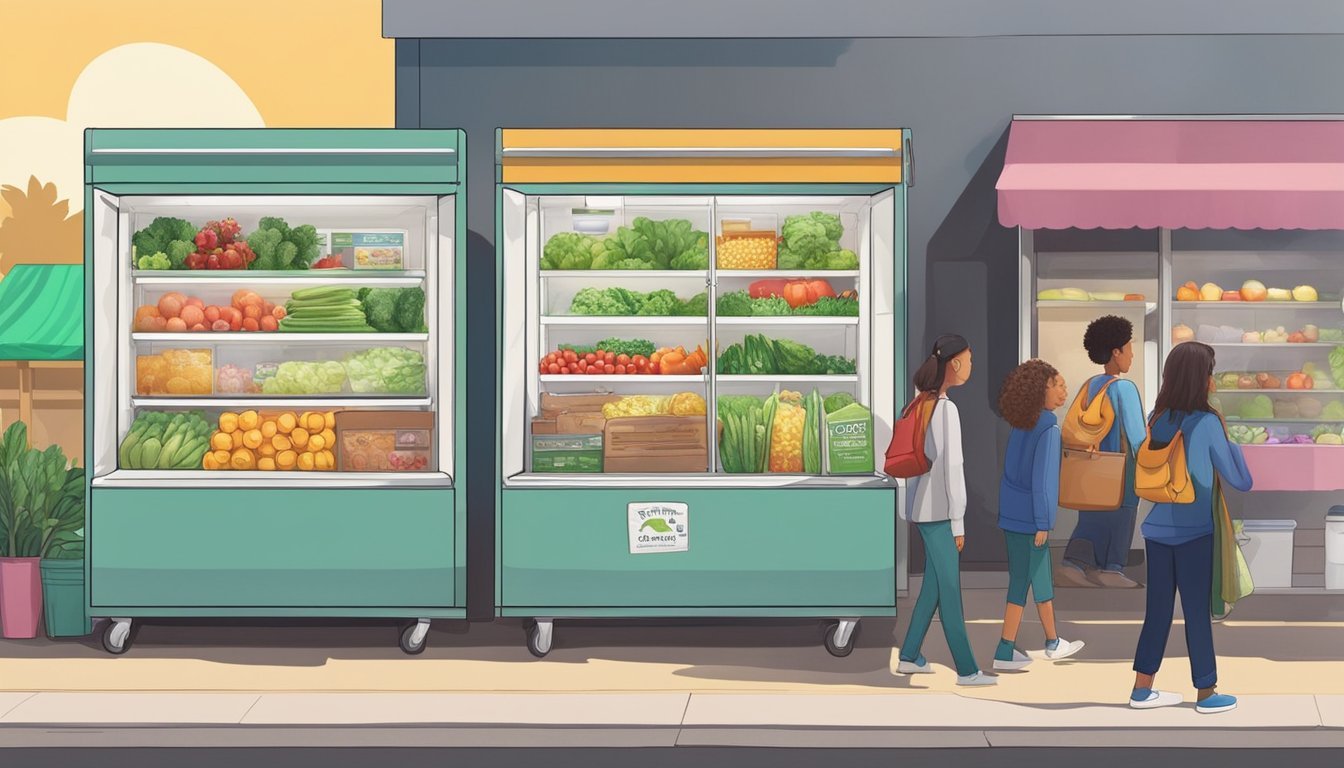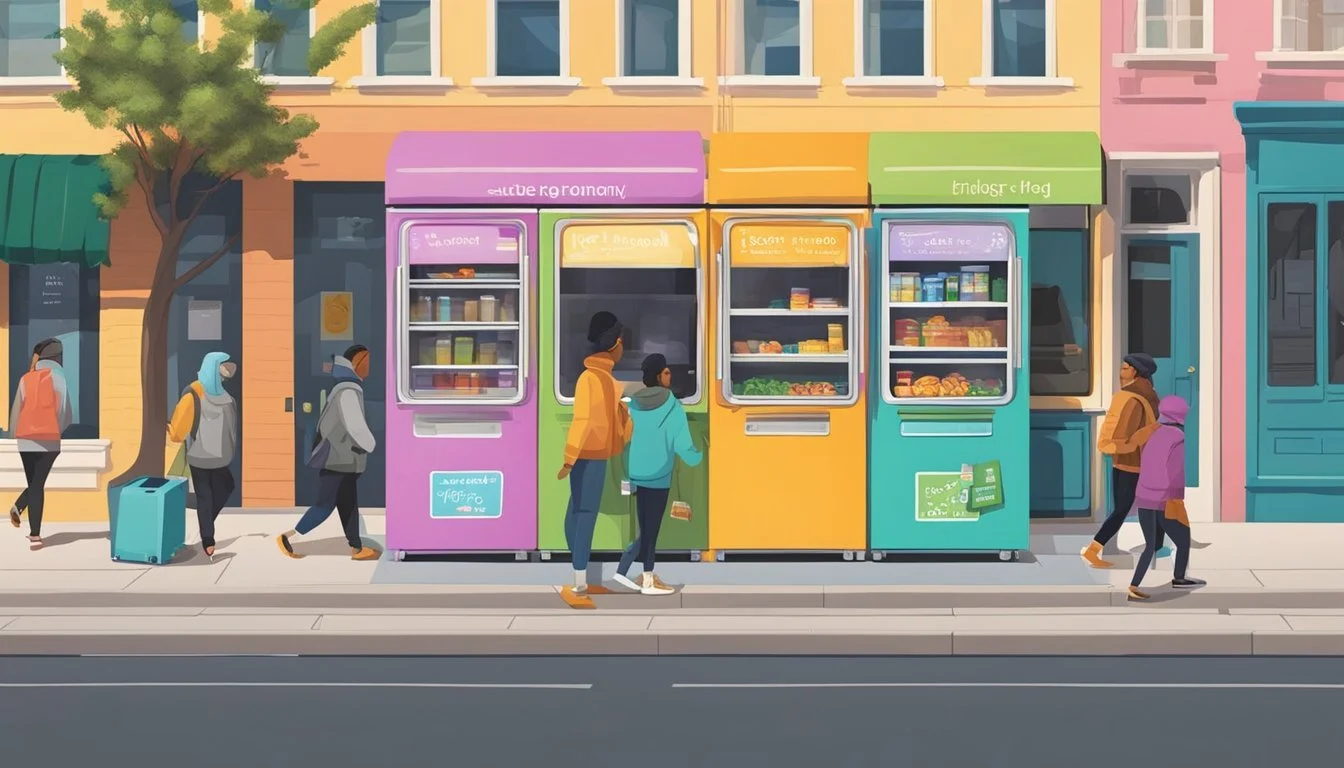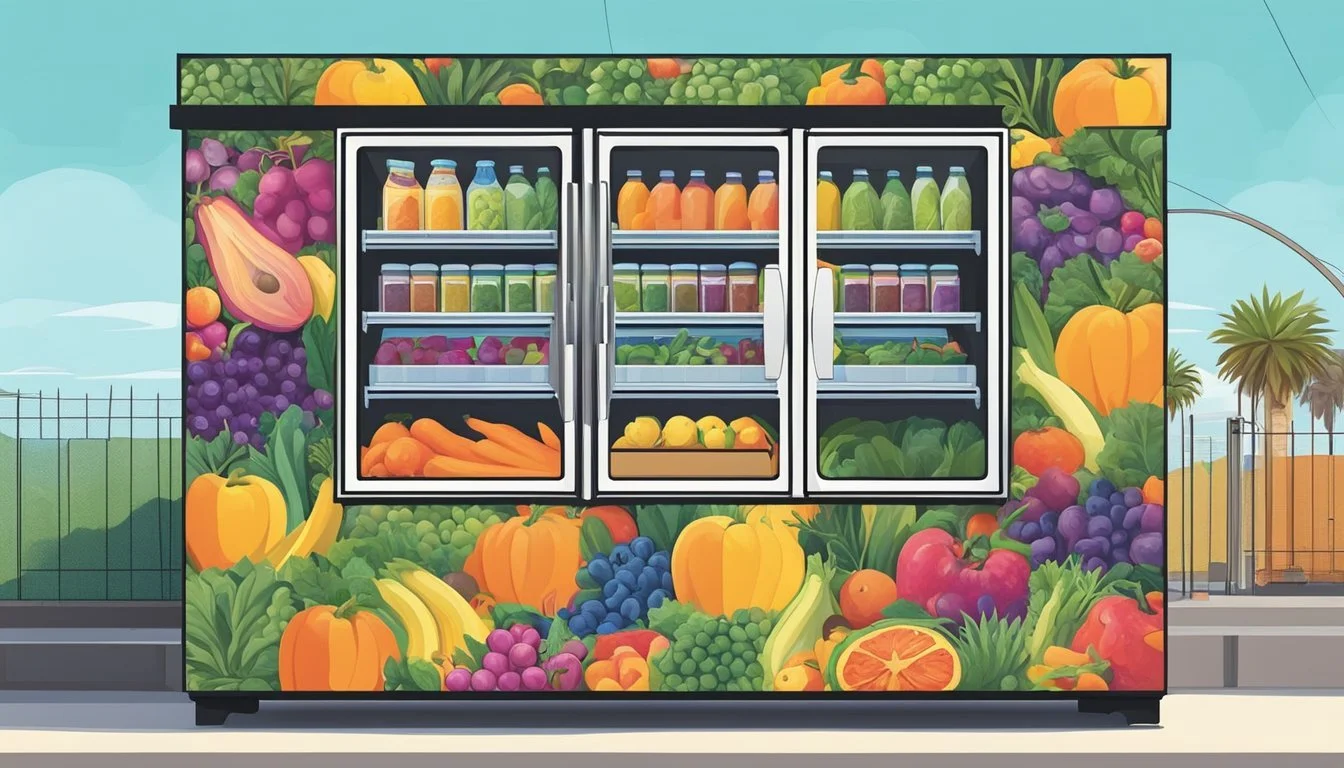Torrance, CA Community Fridge
Nourishing Neighborhood Unity
In Torrance, CA, an initiative to combat food insecurity and foster a sense of community has taken shape in the form of a community fridge. Accessible to all, these community fridges provide a means for residents to share surplus food and resources, benefiting those in need and reducing food waste. Situated in a city known for its diverse population and strong community values, the Torrance community fridge embodies a practical solution to local hunger and supports communal sharing that strengthens neighborhood ties.
Los Angeles County, with Torrance as part of its tapestry, has seen a rise in community fridge installations. These refrigerators are often decorated with local art, turning a simple act of sharing into a community experience. A network of businesses, organizations, and individuals keep these fridges stocked with a variety of nutritious food items. The Torrance community fridge is more than a place to access free food; it represents a hub where the sharing of resources meets the exchange of culture and ideas.
The concept of community fridges in the Los Angeles area echoes a growing movement across the country. In Torrance, the introduction of such a fridge has provided residents with an opportunity to actively participate in a collective effort to ensure no neighbor goes hungry. By fostering an environment where resources are freely shared, the Torrance community fridge is not just a physical space, but a reflection of the community's commitment to inclusivity and mutual support.
Understanding Community Fridges
Community Fridges are a powerful tool to combat food insecurity and reduce food waste, often maintained by volunteers and powered by donations of free food.
Concept and Purpose
Community Fridges, sometimes known as ‘freedges,’ are public refrigerators placed in accessible areas allowing people to take or donate food freely. The premise is to provide a centralized location where:
Individuals can access free food without any barriers.
The occurrence of food waste is minimized by enabling the redistribution of excess food.
These refrigerators are stocked with various perishable and non-perishable items by volunteers or participating members of the community. Food safety is a critical aspect, with most community fridge initiatives setting up clear guidelines on what can and can't be donated.
History and Development
The concept of Community Fridges originated as a grassroots solution to food insecurity and has since evolved with numerous fridges set up across the globe. For instance, Los Angeles has adopted this concept with considerable growth, from a mere 14 refrigerators in August 2020 to managing 25 by a later date.
These fridges serve as open platforms where neighbors help each other. Over time, systems for maintaining and operating community fridges have become more sophisticated, often involving:
Online maps for easy location of fridges.
Organized rotas of volunteers who clean and monitor the stock.
Partnerships with local businesses and farms for a steady supply of items like heirloom tomatoes, eggs, and other fresh produce.
Community Frides like in Torrance are critical nodes in a network of efforts to ensure access to food for all, exemplifying community solidarity and cooperation.
Operational Details
The Torrance, CA Community Fridge provides a vital resource for those in need, maintained through dedicated volunteer efforts and situated for easy public access.
Location and Accessibility
The Community Fridge in Torrance is strategically located for easy reach. Address: 3031 Torrance Blvd, Torrance, CA 90503, at the city's central hub—City Hall. It is marked on local maps, and public transport facilitates convenient access.
Hours of Operation
Accessible 24/7, the fridge ensures that no one is constrained by time when in need of food. Electricity for the fridge is sustained around the clock, guaranteeing that the food remains fresh at all times.
Safety and Maintenance
Regular maintenance checks are conducted to ensure the fridge operates safely and hygienically. It is cleaned and inspected by volunteers to comply with health standards. Spoiled items are promptly disposed of to keep the food supply safe.
Volunteer Participation
A strong volunteer network is the backbone of the fridge's operation. Volunteers are responsible for organizing food, checking quality, and maintaining cleanliness. Anyone wishing to join the efforts can contact the local volunteer coordinator for more details.
Community Impact
The Torrance, CA Community Fridge directly addresses local food insecurity and promotes sustainability through shared community resources. These efforts represent a tangible response to the needs exacerbated by the coronavirus pandemic.
Combating Food Insecurity
The community fridge in Torrance plays a pivotal role in alleviating hunger in the area, particularly during the ongoing challenges of the pandemic. By offering free access to nutritious food, the initiative ensures that individuals and families facing economic hardship have a reliable source of sustenance. The refrigerator is stocked with items such as:
Fresh fruits and vegetables: A variety of produce to promote a balanced diet.
Dairy and eggs: Essential for protein intake.
Non-perishable goods: To assist those who might not have regular access.
Community members are encouraged to take what they need and donate what they can, fostering a sense of solidarity and mutual aid.
Environmental Benefits
In addition to supporting the community through food provision, the Torrance Community Fridge helps mitigate food waste, an important environmental concern. By redistributing excess food that would otherwise be discarded, the fridge contributes to a more sustainable food system. Key environmental advantages include:
Reduction in landfill waste: Less discarded food translates to decreased methane emissions.
Conservation of resources: Sharing food maximizes the utility of water, land, and labor used in food production.
The success of the community fridge reflects a collective commitment to environmental stewardship and resourcefulness.
Support and Involvement
The Torrance, CA Community Fridge thrives on the support and active involvement of local businesses, individuals, and organizations. Through various forms of participation, these groups help sustain and grow the community fridge initiative.
How Businesses Can Get Involved
Businesses have the opportunity to support the Torrance Community Fridge in several ways. They can donate surplus food items, which reduces waste and aids those in need. Additionally, businesses might offer financial support or sponsorship, which can help cover the operational costs of the fridge, including maintenance and electricity.
Donation of surplus food: Grocers and restaurants can provide fresh produce or prepared meals.
Sponsorship: Businesses can sponsor the fridge monthly or annually, aiding its sustenance.
Individual Contributions
Individuals play a crucial role in the success of the community fridge. They can contribute by donating food, volunteering time to clean and organize the fridge, or by spreading awareness through word of mouth and social media. Individual support ensures a steady supply of food and helps maintain the cleanliness and functionality of the fridge.
Food donations: People are encouraged to bring fresh fruits, vegetables, and non-perishable items.
Volunteer: Committing time to the upkeep of the fridge is vital for its operation.
Organizational Partnerships
Organizations, be they non-profits or community groups, can form partnerships with the community fridge. These partnerships can take the form of regular food donations, logistical support, or by aiding with community outreach and education about food security and waste reduction.
Food drives: Organizations can host events to collect food specifically for the community fridge.
Education: They can organize workshops or campaigns to raise awareness about the community fridge and its mission.
Design and Installation
When initiating a community fridge project in Torrance, California, the design and installation are critical phases that ensure the success and sustainability of the initiative. Correctly choosing a refrigerator that meets the community's needs and adhering to installation guidelines are pivotal steps for a functional community fridge.
Choosing the Right Fridge
Size and Capacity:
Selecting a refrigerator with adequate size and capacity is essential to accommodate the volume of food shared. The fridge should be large enough to serve the community but also fit the designated space.
Energy Efficiency:
Opt for an energy-efficient model to minimize electricity costs and environmental impact. Models with an ENERGY STAR rating are recommended.
Durability:
Since the fridge will be accessed frequently, it's important to choose a durable appliance that can withstand the high usage.
Installation Tips and Guidelines
Location:
The fridge should be installed in an easily accessible, visible, and safe location to encourage maximum use and contributions from community members.
Electrical Requirements:
Ensure the installation site has the necessary electrical infrastructure to power the fridge without overloading the system. Professional appliance installation services can provide expertise in this area and may offer installation services.
Maintenance:
Regular maintenance is vital for the longevity of the community fridge. Engage with local appliance repair services to establish a schedule for servicing and potential repairs as needed.
Compliance:
Adhere to all applicable city regulations regarding public appliances and food sharing when installing the community fridge. Check with Torrance city policies for guidance.
Troubleshooting and FAQs
In maintaining the efficiency and longevity of the Torrance, CA Community Fridge, it's essential to be equipped with the right information for troubleshooting common issues, and to have an understanding of the frequent questions that might arise for both volunteers and users.
Common Issues
Cooling Problems: If the Community Fridge is not cooling properly, volunteers should first check the power connection and ensure that the fridge is not overloaded, as this can impede air circulation. A professional repair service may be needed for more complex problems, such as a faulty compressor or a refrigerant leak.
Door Seal Issues: A loose or damaged door seal can lead to energy waste and impair the fridge's ability to maintain temperature. This can often be resolved by cleaning the gasket or contacting a repair service to replace the seal if necessary.
Volunteer FAQs
How can I help with maintenance?
Volunteers can assist by routinely checking the fridge's temperature, cleaning it, and reporting any technical issues to a designated community member responsible for coordinating repairs.
Who should I contact for repair services?
Volunteers should have a list of pre-approved refrigerator repair services, such as local providers with experience in LG refrigerator repair or other specific brands used by the community fridge.
What should I do if I notice the fridge is broken?
Report the issue immediately to the community fridge coordinator. They will liaise with the appropriate repair service.
User FAQs
Can I take food from the fridge at any time?
Yes, the community fridge is accessible to everyone at any time. All food items are free to take.
How do I know the food in the fridge is safe to consume?
Volunteers monitor the fridge regularly to ensure all items are fresh and safe. Users should check expiration dates and the overall quality of the food before consumption.
What kind of items can I donate to the fridge?
Donations of prepackaged salads, fresh vegetables, eggs, and other perishables are welcome. Homemade or expired products should not be donated to ensure safety for all users.
Additional Resources
This section provides valuable resources for those looking to learn about or locate community fridges in Torrance, CA. A variety of maps and directories, along with educational materials, are available to assist individuals and organizations interested in community fridges.
Maps and Directories of Community Fridges
Community fridges are placed in publicly accessible locations to provide free food to those in need, aiming to reduce food waste and insecurity. For those searching for community fridges in Torrance, CA, maps and directories serve as crucial tools.
Online Maps: A digital map pinpointing the exact locations of community fridges in Torrance offers an easy way to find the nearest fridge. Search engines can be utilized to find the most current maps.
Local Directories: Community centers, libraries, and nonprofit organizations may have printed directories listing all operating community fridges, their operating hours, and the types of food typically available.
Educational Materials and Guides
Educational materials provide guidelines and best practices for both users and maintainers of community fridges, ensuring safety and efficiency.
Starting a Community Fridge: Resources are available for individuals looking to set up a new community fridge, including step-by-step guides on obtaining permissions, maintaining hygiene standards, and ensuring ongoing community support.
Usage Guidelines: For those accessing the fridges, educational materials often contain information about how to use the fridges responsibly, what types of food can be taken, and how to contribute.
By utilizing these resources, Torrance residents can effectively participate in the community fridge movement, contributing to a more sustainable and food-secure future.
Future of Community Fridges
The future of community fridges in Torrance, CA, lies in embracing technological advancements while expanding their reach. Their evolution will demonstrate how local actions can resonate with broader community welfare objectives.
Innovation and Technology
Community fridges in Torrance are set to leverage technology to improve food distribution efficiency. These systems might incorporate real-time inventory tracking or data analytics platforms to assess food turnover rates. This data-driven approach can help reduce waste by stocking items that match community needs. Furthermore, smart fridges with digital interfaces could facilitate easier access for residents and provide data on high-demand periods for better stocking and volunteer coordination.
Design innovations are also anticipated, with fridges possibly featuring solar-powered cooling systems or modular designs that can be easily replicated across different neighborhoods. In New York City, for example, the integration of design and technology in community fridges has been pivotal for both functionality and community engagement, and this model provides a valuable blueprint for Torrance.
Expansion Plans
The leadership in Torrance plans to scale the community fridge initiative. They may aim to double their network, introducing fridges in areas with higher foot traffic or in neighborhoods that lack access to fresh food. Expansion strategies are likely to include:
Partnerships with local businesses and organizations to secure sustainable support.
Educational programs to inform residents about the benefits of community fridges and to promote responsible usage.
Development of logistical frameworks to ensure the consistent supply of quality produce.
Expansion is also tied to the variety of products offered. While starting with food items, community fridges can evolve to provide essential non-food items, reflecting initiatives seen in other locations like New York. These might include hygiene products, kitchen utensils or even books, with the aim of addressing broader issues beyond just food insecurity.
Legal and Ethical Considerations
In addressing the operation of community fridges like the one in Torrance, CA, it is imperative to consider both legal and ethical aspects to ensure compliance with regulations and maintain community trust.
Health Regulations
Community fridges are subject to health regulations to prevent foodborne illnesses and ensure public safety. Operators must adhere to the guidelines set forth by local health departments, which commonly include:
Temperature Control: Food must be kept at safe temperatures to inhibit bacterial growth.
Labeling: Donated food should be labeled with expiration dates and storage instructions.
Cleanliness: Regular sanitation of the fridge and surrounding area to maintain hygiene standards.
Strict compliance with these regulations is vital for the ongoing success and public endorsement of community fridges.
Food Donation Liability
The liability associated with donating food to a community fridge can often be mitigated by the Good Samaritan Food Donation Act. As per this federal law, donors are protected from liability when donating to a non-profit organization, as long as the donation is made in good faith. Key points include:
Donor Protection: Civil and criminal liability protection for donors who give food in good faith without gross negligence or intentional misconduct.
Food Quality: Donated food should be wholesome and not knowingly mislabeled, adulterated, or unsafe.
Adhering to these statutes significantly reduces the legal risks involved with food donations, while encouraging the reduction of food waste and supporting food security in the community.
Testimonials and Case Studies
Community fridges in Torrance have become a cornerstone in the fight against food insecurity. Testimonials from individuals and success stories from the community offer insight into the project's impact.
Personal Experiences
Individuals in Torrance express gratitude for the community fridge project, highlighting its around-the-clock availability as a crucial resource. One Torrance resident mentioned, "The fridge helped me feed my family during a tough month," illustrating the immediate, personal benefit of the project. Another shared how convenient it was to contribute excess produce from their garden, fostering a sense of solidarity and participation within the community.
Community Success Stories
Organizations involved with the Torrance community fridge consistently report a significant reduction in local food waste. They share statistics stating that the project has managed to redistribute hundreds of pounds of food that would otherwise have gone to waste. Partnerships with local businesses, such as Best Buy, have resulted in donations of gently used refrigerators that power the project, thereby merging sustainability with social impact. The engagement has grown so that Davis, a key volunteer, can recount stories of families who can now reliably find fresh vegetables and healthy snacks for their children.
Conclusion
The Community Fridge initiative in Torrance, part of the Greater Los Angeles area, represents a significant step toward addressing food insecurity. With a focus on community support, these refrigerators provide an essential resource for those in need. They operate on a simple principle: anyone can leave food, and anyone can take it, ensuring a constant flow of provisions.
Torrance's residents have shown a strong sense of community through their participation in and support of the local Community Fridge. It's a testament to the collective effort to combat hunger and reduce food waste within the city. The fridge is not just a passive repository of food but a symbol of mutual aid and community solidarity.
The sustainability of these initiatives relies on a continuous loop of generosity: local businesses, organizations, and individuals coming together to keep the fridge stocked. In the context of Los Angeles, known for its large population and diverse communities, the success of such programs embodies a beacon of hope for other cities grappling with similar challenges.
In conclusion, the Community Fridge in Torrance is more than a solution to food scarcity; it's a reflection of the strength found in community collective action. As Los Angeles continues to expand these networks, the positive impact on food insecurity looks promising, reaffirming the value of shared community resources in enhancing the well-being of all residents.













